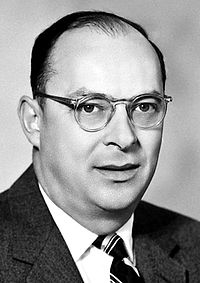One Of The Greatest Scientists You've Never Heard Of
19 Nov
Posted by RD Bentley as Science Sightings, Technology
Meet The American Physicist Who Changed Our World
 Arguably, John Bardeen changed the world more than any other scientist in the latter part of the 20th century. Bardeen and a few of his very bright friends came up with the invention that sparked an electronic revolution, and burgeoned further than any one of us could ever have imagined.
Arguably, John Bardeen changed the world more than any other scientist in the latter part of the 20th century. Bardeen and a few of his very bright friends came up with the invention that sparked an electronic revolution, and burgeoned further than any one of us could ever have imagined.
But how come you’ve never heard of the great John Bardeen? This is a phenomenon within itself. It’s probably because John Bardeen was an unassuming person, and the media outlets may have overlooked his magnificent contributions to the science community because of his unselfish character.
Before the transistor, vacuum tubes had been used in electronics. They were big, bulky, short lived, and burned out too often. In 1945, AT&T saw the need to replace the vacuum tube with a more viable option. AT&T set out to pull a team together to solve the problem. AT&T asked William Shockley to start a research department.
On December 16, 1947, a critical experiment was going to be carried out by two great scientific minds – John Bardeen and his friend Walter Brattain. William Shockley, who the two had been working with at Bell Labs, would get credit as well, even though he played a limited role in the discovery. In fact, Shockley wasn’t even present when Bardeen and Brattain became aware of their victory. Shockley demanded that his role should receive recognition.
Bardeen got very angry over Shockley’s undeserving credit, especially when the September edition of a magazine came out, with the prominent figure of Shockley on the front cover.
From November 17 to December 23 of 1947, the Brattain and Bardeen team would conduct experiments to discover why Shockley’s previous attempts had failed. William Shockley could not get his amplifier to work, which he had used silicon in the process. The team would switch from silicon to germanium. The spark of genius was about to change the world.
On December 23, 1947, Bardeen and Brattain without Shockley, successfully invented a point-contact transistor that amplified. The first working solid state amplifier had come to fruition. The transistor is probably one the most greatest inventions of the 20th century.
What can we say about the importance of the transistor? The transistor is virtually in every electronic device on the market. For more than sixty years, the transistor has transformed the world of electronics. The transistor has been called “the fundamental building block of the information age”.
In 1956, John Bardeen shared the Nobel Prize in Physics with William Bradford Shockley, Jr. and Walter Houser Brattain. In 1972, Bardeen shared the Nobel Prize in Physics with Leon Neil Cooper and John Robert Schrieffer. Bardeen even became the first person to win two Nobel Prizes in the same field! The first Nobel was for inventing the transistor. The second Nobel was for developing a theory of the mechanism underlying superconductivity.
On December 14, 2006, the American Physical Society honored Bardeen, Shockley, and Brattain by presenting a plaque to Bell Labs.
John Bardeen belongs to a group of elite scientists of the age. In 1972 John Bardeen did something that no other physicist, not even Albert Einstein, had ever done. He won his second Nobel Prize in physics.
Subscribe Now!
Featured Deal ➸
Social Button ➸
Categories
- 1
- 111
- 5
- 7Slots
- 9
- a16z generative ai
- Amateur Radio
- antikaeltehilfe.de
- atlantikcorner.com
- bauhutte-g.com
- blog
- Bookkeeping
- Casino
- Cryptocurrency exchange
- extension-autoroutes-non.ch
- Forex Trading
- Future Tech
- Geeky Tips
- Going Green
- Going Mobile
- News
- Pin-Up AZ
- Pin-Up indir
- Pin-Up oyunu
- Pin-UP VCH
- Post
- Product Reviews
- ready_text
- restaurantelacontrasena.com
- Scanner Listening
- Science Sightings
- Sober living
- Technology
- texts
- thomas-petandfamily.de
- Uncategorized
- Новости Криптовалют
- Новости Форекс
Archives
SQUIDBOARD
Academic Tech
Multimedia MegloMania
Tech Toolbox
- Acronis
- AN/GRC-9
- Apple Final Cut Pro
- Audacity
- Audacity VST Plug-ins
- BleachBit
- ClimateViewer 3D
- Cool Edit Pro 3.1
- CyberGhost
- Flickr
- FreeSCAN
- fring
- Fruper
- FTA Lists
- GPS Calculator
- GPS Converter
- HAMSOFT
- HF Antennas
- inSSIDer
- Levelator
- MaxMind
- Microphone Cables
- Morse Code Chart
- Old Version
- Pendriveapps.com
- PortableApps.com
- Privacy Badger
- PulseAudio
- Rowetel
- ShopJimmy
- Teleprompter Software
- TV Listings
- UNetbootin
- Voicemeeter Banana
- Winlink
RSS feed for comments on this post · TrackBack URI
Leave a reply